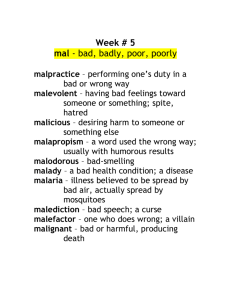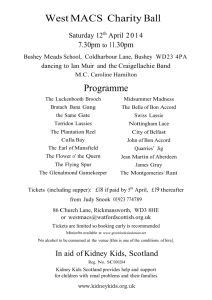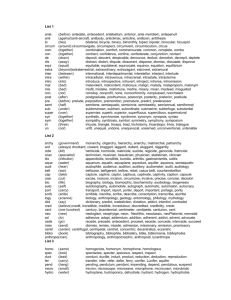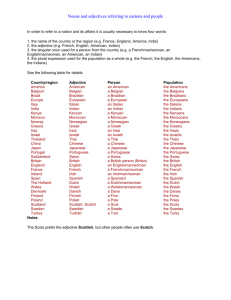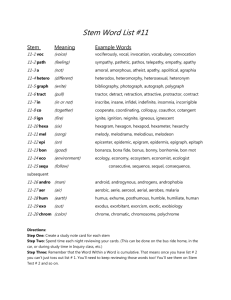AMB240 Final - WordPress.com
advertisement
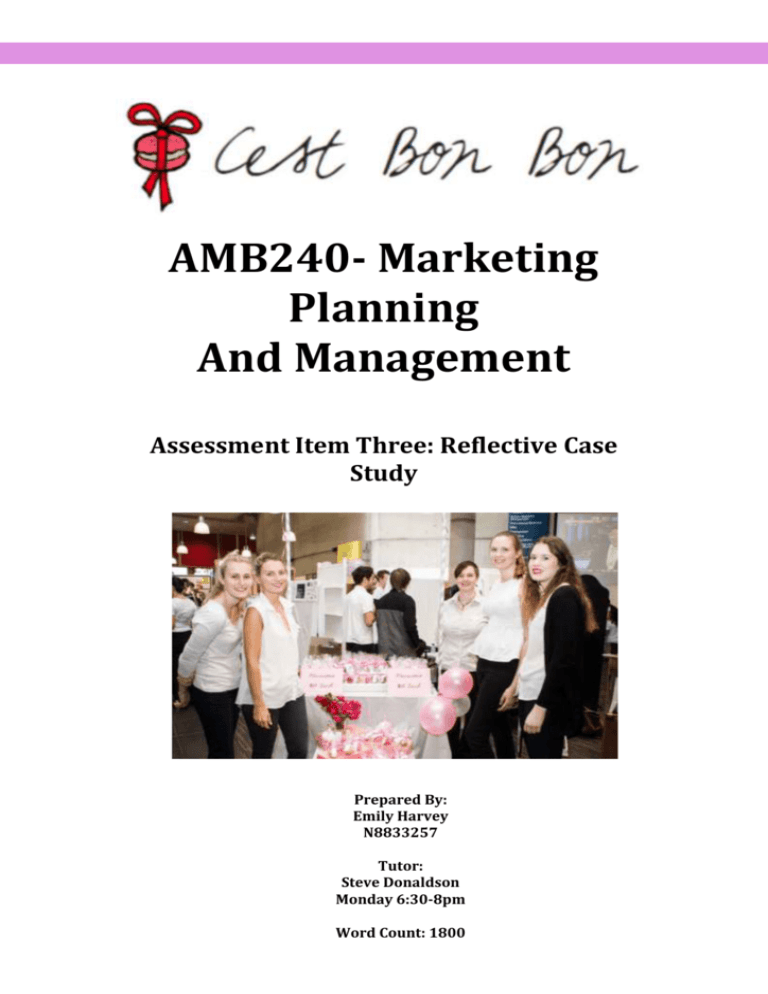
AMB240- Marketing Planning And Management Assessment Item Three: Reflective Case Study Prepared By: Emily Harvey N8833257 Tutor: Steve Donaldson Monday 6:30-8pm Word Count: 1800 Executive Summary: The following report outlines the outcomes and issues C’est Bon Bon faced during the QUTopia market day stimulation. Included within this report are the outcomes of C’est Bon Bon marketing objectives that revolved around market share, customer loyalty, customer satisfaction, profit outcomes and sales total. Upon analysis of these objectives it was revealed the C’est Bon Bon achieved a high level of business success with most objectives being reached over greatly exceeded. This success was further demonstrated in C’est Bon Bon market share of 46.15% over two key competitors. However, over the progression of the two-market day C’est Bon Bon was faced with numerous issues, with the three that were deemed to have the highest impact on C’est Bon Bon success being discussed. These included inconsistency in price, product demand, and measurement of customer satisfaction. Recommendations were then implement to provide appropriate solutions to each key issues. For price inconsistency it was suggested that C’est Bon Bon implement a price that reflected better against competitors. As price impact demand it was suggested that a increase in price would have been an effective tool of increasing the supply levels across the marketing day so that C’est Bon Bon could compete for the entire hour. Finally to measure customer satisfaction it was determined that electronic surveys are more successful then paper survey, at recording honest feedback from customer, therefore C’est Bon Bon should have implemented this. 2 Table of Contents Executive Summary: ......................................................................................................... 2 1. Summary Of Marketing Outcomes ........................................................................ 4 1.1 Marketing Objectives And Outcomes ........................................................................ 4 Table 1: The marketing objectives of the original plan and their outcomes ....................... 4 1.2 Sales And Promotion ....................................................................................................... 5 Table 2: Sales and production outcomes from the market days. ........................................... 5 1.3 Final Profit and Loss Statement................................................................................... 6 Table 3: Profit and Loss Statement .............................................................................................. 6 1.4 Marketshare Calculation ................................................................................................ 7 Table 4: Market share analysis..................................................................................................... 7 2 Key Issues Arising From QUTopia Simulation ................................................... 8 Table 5: Summary of Marketing Management Issues .............................................................. 8 3 Problem Identification............................................................................................ 10 3.1 Price Inconsistency ............................................................................................................10 3.2 Product Demand .................................................................................................................12 3.3Customer Satisfaction ........................................................................................................12 4 Statement and Evaluation Of Alternatives ....................................................... 13 Table 6: Statement and evaluation of alternatives ................................................................13 5 Recommendations For The Future ..................................................................... 14 6 Appendices .................................................................................................................. 16 Table 7: Forecasted Profit and Loss...........................................................................................16 Table 8: Sale Forecast ..................................................................................................................17 Figure 9: Forecasted break even. .............................................................................................17 Figure 10: Actually break even results....................................................................................18 Figure 11: Business Performance Results ..............................................................................18 7. Reference ....................................................................................................................... 19 3 1. Summary Of Marketing Outcomes 1.1 Marketing Objectives And Outcomes Table 1: The marketing objectives of the original plan and their outcomes Objective Market Share Customer Loyalty Measure 1. Gain at least 30% market share 2. Achieve 50% of customers returning at Market Day 2 Customer Satisfaction 3. To achieve 50% customer satisfaction Profit Outcomes 4. To make at least $3,300 profit Sales Total 5. To sell at least double our break-even point overall 4 Outcomes This was achieved. Market share was 45.71%. This was not achieved. C’est Bon Bon had 39.85% returning customers at Market Day 2. According to the customer surveys in week 1, C’est Bon Bon had 100% customer satisfaction. C’est Bon Bon exceeded this expectation, making $5,058 profit overall. C’est Bon Bon achieved this objective (break-even point 68 Macarons- 248 sold) 1.2 Sales And Promotion Table 2: Sales and production outcomes from the market days. ($Q) QUTopia Sales and Production Table Initial Inventory No. of units currency 248 01. Sales (single packs & double packs) 02. Sales price per unit $30 03. Total number of units produced 171 04. Total number of units sold 171 07. Total turnover $5,130 ($Q) QUTopia No. of units currency 01. Sales (Three Packs) 02. Sales price per unit $26.67 03. Total number of units produced 24 04. Total number of units sold 24 07. Total turnover $640 ($Q) QUTopia No. of units currency 01. Sales (More than 3 purchased & price decrease) 02. Sales price per unit $25.00 03. Total number of units produced 36 04. Total number of units sold 36 07. Total turnover $900 ($Q) QUTopia No. of units currency 01. Sales (Price Decrease) 02. Sales price per unit $20.00 03. Total number of units produced 17 04. Total number of units sold 17 07. Total turnover $340 Average Price per unit Stock Left on Hand Grand Total Turnover 5 $28.67 0 $7,010 1.3 Final Profit and Loss Statement Table 3: Profit and Loss Statement CAPITAL Amount of start-up capital Amount of capital retained $4,000 $2,100 PROFIT & LOSS ACCOUNT Marketday 1 and 2 Note 01. Income 02. Turnover (total sales) 03. Cost of Sales (Production) 04. Materials (eg. Product costs, packaging) 05. Wages/ Salaries 06. Total ($AUD) real currency ($Q) QUTopia currency Sub Total $ 7,010 McDonalds supplied our products for free $ 15 $ $ 7,010 - $ 1,300 $ 1,315 07. GROSS PROFIT 08. Distribution 09. Stall cost 10. Delivery Costs (e.g., postage) 11. Total 12. Expenses 13. Lecture promotion 14. Market research 15. Other expense 1 (eg. Stall design/decoration) 16. Other expense 2 (eg. staff performance) 17. Total Expenses 18. NET PROFIT BEFORE TAX Profitability of the organisation Calculated as net profit/turnover 6 Total $ 5,696 $ $ $ - 38 - $ 600 $ - $ $ - $ $ - $ 600 $ 38 $ 5,058 72.15% 0.721469 1.4 Marketshare Calculation Table 4: Market share analysis Product Turnover (No. of units Profitability Price (Av. Price Profit ($) sold) (%) per unit, $) 45.71 5,058.00 248 72.15% 28.27 4,870.00 31.76 2,980.00 108 61.19% 45.09 Berried 3,455.00 22.53 1,505.00 74 43.56% 46.69 Total industry 15,335.00 100.00 9,543.00 430 62.23% 35.66 C’est Bon Bon (Total Market sales, $) share (%) 7,010.00 Competitor 1: Silver Spoon Competitor 2: Average industry profitability 7 62.23% 2. Key Issues Arising From QUTopia Simulation Table 5: Summary of Marketing Management Issues Financial Situation C’est Bon Bon’s forecasted profit and loss, shown in table 7 of the appendix, predicted that C’est Bon Bon would make a total profit of $2,785 resulting in a 55.92% profitability for the company. However, as shown in the final profit and loss statement in table 3 above, C’est Bon Bon exceeded this forecast by actually making $5,058 across both market days resulting in a 72.15% profit to the company. C’est Bon Bon was marketed as a premium product which allowed C’est Bon Bon to charge a substantial rate for the macarons. By charging a premium price of between $20-30 C’est Bon Bon was able to surpass its sale objective of making $3,300 by $1758. C’est Bon Bon original forecast assumptions were constructed around the information provided from previous business results, also considering there was a much lower number of specialty food competitors at market day 2014 compared to previous years, resulting in C’est Bon Bon forecasting a market share of 32% with 166 units being sold, as shown in table 8 of the appendix. However, once again C’est Bon Bon exceed this expectation with a total of 248 units being sold resulting in a market share of 45.71% C’est Bon Bon over budgeted in terms of the amount of money that would be required to package our premium product as well as develop our stall’s luxurious appearance, with only $53 being spent by C’est Bon Bon compared to the forecasted $95. Due to this over budgeting and lower number of sales being predicted, C’est Bon Bon was required to sell 71 units to break even, as shown in figure 1 of the appendix. However, as seen in figure 2 C’est Bon Bon’s actual break even point was 68 units which was exceeded by C’est Bon Bon selling 248 units. Positive: C’est Bon Bon had a 72.15% profit meaning little money had been spent by group members. Positive: charging a reasonable rate that reflected our brands image of being premium allowed for greater amount of revenue being earned. Neutral: Had C’est Bon Bon’s original forecast been more accurate on the amount of expected units being sold , C’est Bon Bon would have been able to cater to this figure resulting in product not selling out as quick. Positive: As spending less actual money on stall and product miscellaneous decreased C’est Bon Bon’s variable unit cost from the forecasted $0.33cents a unit to $0.06Cents a unit. Resulting in less sales being needed to break even. Positive: As C’est Bon Bon was able to save $200 real money, that would have been needed to purchase the macarons had McDonalds not sponsored. As C’est Bon Bon’s product was sponsored entirely we weren’t faced with any unexpected financial issues. Company Analysis 8 Overall the performance of the C’est Bon Bon marketing team was exceptional, with each member being approachable and easy to work with. To aid continuous communication outside of tutorial a Facebook group was created in which group members could ask questions, help make group decisions as well as providing reminders of tasks that needed completion. Each individual pulled their weight when it came to fulfilling their individual job descriptions. Additionally, team members actively attended tutorials to have weekly face to face debriefs, as well as offering assistant in filling out the weekly worksheets. Outcome was extremely positive due to the hard work and continual support that each individual provided throughout the assessment. Everyone respected one another’s ideas and were always polite when offering ways to improve team members work, which resulted in the complete lack of conflicts between any members. hhhh Financial Situation Finally a participative management style (Ryan, n.d.); which encouraged all team member to be involved in decision making, was utilized which ultimately lead to higher level of productivity as well as increasing group morale. Marketing System Objectives focused mainly on attainable and realistic goals, lacking specificity on how these goals were to be measured and in what time frame they needed to be achieved. Neutral: Recognized a need to implement measurement tools after market day 1 C’est Bon Bon underestimated the high level of sales that macarons generate which lead to problems arising in regards to the under catering for the demand. Negative: Missed out on potential sales and market share attainment by not having product to sell. C’est Bon Bon had an industry engagement with Kenmore McDonalds, as a result of me being a long time employee. McDonalds provided C’est Bon Bon with the 248 macarons sold across the market days. Positive: C’est Bon Bon team members weren’t required to spend money on the product. There were major inconsistencies in the price during market day one as team members allowed customers to haggle on the price. Presentation and quality of the product as well as our market stall being placed in a conveniently located section of the market allowed for easy attainment of customer attention and business. C’est Bon Bon poorly implemented the use of satisfaction surveys at market day one with only 15 survey being completed. Negative: Missed revenue, also impacted on C’est Bon Bon selling out so quickly. Positive: Were able to attract and retain interest. Negative: Sample size of survey respondents was not high enough to determine actually customer satisfaction. Customer Analysis Positive: As C’est Bon Bon was able to successfully appeal to this large target audience through the use of feminine colours and packaging style. C’est Bon Bon target market was accurately recognized as young female optimists between the ages of 18-25. This could be due to the fact that 130 females whom fell mostly into the 18-25 age bracket were involved in the AMB240 stimulation, compared to only 77 males. After reviewing the Business performance results; as shown in figure 3 of the appendix, C’est Bon Bon’s product was more likely to be purchased for an emotional reason rather then the social proposition that was predicted due to the attributes of young optimists. Positive: Although incorrectly determined the emotional proposition allowed for a greater section of the market to be captured. This emotional connection could have been experienced due to mothers day being after market day one. One of C’est Bon Bon’s biggest failures was the estimation of customer demand; which greatly impacted our ability to satisfy potential customers as well as actively compete for the entire hour. Negative: As an inaccurate customer demand calculation was used C’est Bon Bon failed to have the required units to cater to the demand. 9 Competitor Analysis Critically evaluate your identification of competitors, your competitive strategies and responses to competitive activity. Positive: The successful C’est Bon Bon accurately identified its key competitors prior to identification of key competitors, the commencement of market day one. As seen above in table 4, C’est Bon Bon performed exceptionally gave C’est Bon Bon a competitive when compared against the key competitors, gaining 45.71% of advantage, as we were able to analyze our competitors products the market share with total profit double that of either and prices which allowed for the competitor. implementation effective ways to combat our competitors. C’est Bon Bon strengths over its’ competition was in the packaging of the product. The enclosed packaging made the macarons easily transportable; giving customers justification to Positive: C’est Bon Bon wasn’t restricted to selling to customers purchase the product to eat later in the day when they were whom wanted to eat the product feeling like something sweet. Futhermore, the feminine then and there. presentation of the product made it the perfect gift to buy for mother’s day. Negative: Competitors were able to gain customers due to the enjoyment Unfortunately as product stock was limited C’est Bon Bon was levels triggered by sampling the unable to provide taste samples, which competitors were able product. Further leading to positive to distribute. word of mouth being spread through the market place. 3. Problem Identification After completion of the above summary of Marketing Management Issues the problems of price inconsistency, product demand and customer satisfaction were determined to have had the most detrimental affect on C’est Bon Bon Business performance. 3.1 Price Inconsistency Inconsistency with prices, which predominantly affected market day one but also appeared in market day two was a major issue identified to affect C’est Bon Bon performance. Although C’est Bon Bon received the highest revenue then any other store competing in market day one and two, due to fluctuation in price and the implementation of new bundling packages the reported final revenue is just a reflection on the total of sales C’est Bon Bon made which could have been higher had C’est Bon Bon stuck to its forecasted pricing strategy. At market day one C’est Bon Bon had a price lining strategy implemented that charged $30 for one macaron, $60 for two macarons and $80 for three macarons (Solomon, Hughes, Chitty, Marshall, & Stuart, 2012). However, as the $80 for three macarons was the 10 most economically valuable customers swarmed to this product resulting in C’est Bon Bon selling out of bundles within 30 minutes of market day one beginning. This issue was due to ideals surround decoy pricing in which the single and double packs of macarons were; due to their prices being equivalent, unfortunately used as a decoy to push the value proposition of the three packs of macarons (Olyslager, n.d.). Had C’est Bon Bon recognised the benefit associated with decoy pricing there could have been the implementation of larger bundle packs as a way to increase profit margins. Furthermore, C’est Bon Bon neglected to take down the price advertisement for the bundles of three customers started enquiring if they could be bundle the individual and two packs of macarons to equal a 3 pack and be charged the advertised price of $80 instead of sticking to the pricing strategy and charging $90. Wanting to uphold customer satisfaction the C’est Bon Bon team agreed with the enquiring customer and only charged them $80 resulting in a loss of $10 every transaction. Additionally, as customers increased the number of macarons purchased it was implemented that the price to purchase was lowered with every customer whom purchased six or more macarons were only charged $25 a macaron. After the completion of market day one the team was able to reflect on this issue, which lead to the realisation of the amount of money that had been lost due to implementation of a price that hadn’t been properly analyses by the team. Due to the correlation between customer satisfaction and price tolerance C’est Bon Bon believed that due the high volume of sales and expected high level of satisfaction on market day 1, removing the economically pleasing bundles of three for $80, would still entice customers to purchase the product, due to competitors prices being on average $15-$17 more expensive then C’est Bon Bon (Anderson, 1996). Although this strategy was implemented for a majority of sales there was still price inconsistency present with returning customers wanting to buy the macarons for the same price as market day one, in which 11 some cases this desire was upheld with a individual customer buying 15 macarons for $25 each resulting in the lose of $75 in a single transaction. 3.2 Product Demand C’est Bon Bon experienced an overwhelming demand for product which unfortunately was not able to be met with the amount of product we had available. Although C’est Bon Bon strategically positioned its price to be reasonable amongst the prices charged by key competitors, our price ultimately was too low which in an elastic demand environment resulted in our stall being inundated with customers who were wanting something sweet but didn’t want to pay the higher prices of our competitors. However, as C’est Bon Bon ran out of product with half an hour left of market day one trading hours we ultimately gave our competition an advantage as consumers were forced to pay their high price to satisfy their wants and needs of something sweet. 3.3 Customer Satisfaction Customer satisfaction is an extremely important component of running a successful business, as it is a mean of generating customer loyalty resulting in the repurchase of products as well as spreading positive word of mouth (Solomon et al., 2012). Although C’est Bon Bon acknowledged the importance of customer satisfaction the implemented measurement tools of a paper survey to determine customer satisfaction was not effective in recording these outcomes. The customer satisfaction of 100% given by 15 customers surveyed over market day one was not indicative of actual customer satisfaction due to incredibly small sample size. Furthermore there was a potential in for a bias to present in respondents answers as the survey were required to be filled out in front of team members with the completed survey being handed back to a team member who could easily review the answers given (textbook). Over market day two C’est Bon Bon assumed customer satisfaction was achieved if customers returned, with 12 every customer being asked if they had purchased our product on market day one. Through poorly measuring customer satisfaction C’est Bon Bon missed out on pinpointing attributes of our product or service that weren’t favourable amongst customers. By having dissatisfaction highlighted C’est Bon Bon could have actively work to eradicate issues put forward; which could have been beneficial to implement on market day 2 to satisfy the 80 new customers that approached C’est Bon Bon, As shown in figure 4 of the appendix. 4. Statement and Evaluation Of Alternatives Table 6: Statement and evaluation of alternatives Problem Bundle prices were to economically pleasing to consumer Advertising of lower price bundles. Allowed some consumers to pay the same price as market day one Ran out of product on both market days Customer satisfaction was not measured affectively. Team members forgot to hand out surveys 13 Solution Increase price to reflect that of competitors Had a variety of interchangeable pricing signage that could be changed to reflect the demand of the market. Explain to customer that due to increasing demand we are unable to sell product at last weeks lower price. Approached another McDonalds franchise to enquire if they would also be able to sponsor macarons. Purchase macarons at a discounted price from McDonalds Implemented an easy to fill out electronic survey that once submitted couldn’t be viewed by a C’est Bon Bon team member. Posted a electronic survey onto the QUTopia Facebook page. Positive Demand for product wouldn’t have been so intense resulting in C’est Bon Bon being able to compete for the full hour of trading. Consumers wouldn’t have been made aware of cheaper bundle options resulting in higher profit margins being achieved. Increase in profit margin Negative C’est Bon Bon wouldn’t have been viewed as the “next best” alternative to our competitors if we had similar pricing, causing customer to justify spending money at our competitors stalls. Price fluctuation may have discouraged customer to purchase the product when it was at a high price with hopes that the price would lower again when the end of trading approached. Potential loss of customer return and satisfaction as customers wouldn’t be interested in repurchasing a product at a higher price. Would have increased the number of units we had available, which hopefully would have been able to cater for the demand. Purchasing enough macarons to cater for the demand would have impacted C’est Bon Bon level of profitability. Would have decreased bias as customers could give honest opinions without feeling awkward about giving their easily identifiable raw data to a team member. Would have gained feedback from customers that were missed at market day. Impacts on the shopping experience by having to answer questions about a product that has just been purchased. Unable to facilitate who responded to the survey, which may have resulted in people filling out the survey as a joke, or to give false data. Also less likely for survey to be completed as there is no obligation. 5. Recommendations For The Future The following section looks at the appropriate solutions in which I believe C’est Bon Bon could easily implement to manage the key problems that arose during market day; which included bundle pricing being to economically pleasing to consumer, advertising the price of past deals as well as selling product at a price inconsistent with the teams implemented pricing strategy and poor measurements of consumer satisfaction. C’est Bon Bon implemented a market penetration price strategy that is characterised as a product of high quality being kept at a low price to drive out competitors (Williams, 2010). However, C’est Bon Bon should have reviewed the prices of key competitors before the commencement of market day one to evaluate if their price reflected similarly. Had this been implemented C’est Bon Bon would have been able to recognise that on average we were charging $15$17 less then our competitors which could have been justification for C’est Bon Bon to marginally increase our product price by as much as $10 as a way of still being the cheaper alternative, but also as a way of reflecting C’est Bon Bon premium brand image by being priced at a value that wasn’t perceived as the cheaper alternative impacting on consumer perception of the quality of our product. C’est Bon Bon should have focused more research on demand-based pricing strategies, with a further analysis into the yield management method that aims to predict the customers who will pay full rate, those who only want to pay discounted rates allowing a percentage of capacity for each group being established (Solomon et al., 2012). For market day two C’est Bon Bon should have polity explained to customer that due to increasing demand for our delicious product we are unable to charge the cheaper prices of market day one. Although this would have impacted returning 14 customers decision to not purchase the product the large number of new customers that visited the store in market day two would have subsidized the loss resulting in a higher profit margin being gained rather then selling the product at a lower price to satisfy existing customers. Alternatively, C’est Bon Bon should have had numerous pricing signs prepared so that once a particular product sold out they weren’t advertising it. As C’est Bon Bon had no other pricing advertisements at market day one they were required to keep up the sign that read three for $80, resulting in customers making bundles of three out of the remaining macarons. Had C’est Bon Bon taken down the sign that displayed three for $80 and replaced it with a sign that only had the two remaining products price on customers wouldn’t have been made aware of the previously cheaper price and would not have enquired about purchasing the remain product at the lower price. Furthermore, C’est Bon Bon should have previously discussed at what rate of selling would we increase or decrease the price so that an evaluated answer could have been decided on with the corresponding price values being prepared to use if required. Due to research findings stating that electronically generated surveys generate both lengthier and self-disclosing comments then paper based survey, C’est Bon Bon should have implemented the use of electronic surveys that had three easy to answer questions as a way to measure customer satisfaction. Through this implementation team members wouldn’t have to spend valuable time; which otherwise could have used to attract new customers, waiting for customers to fill out written surveys. Furthermore, customer bias would have decreased as customers could give honest opinions without feeling awkward about giving their easily identifiable raw data to a team member, rather they hit the submit button which resets the survey to being blank before giving the I-pad back to a team member. Additionally a secondary survey should have been implanted to survey returning customers on market day two, as this would have given better indication of customer satisfaction levels with existing customers being able to actually 15 explain what they enjoyed about the product after experiencing it at market day one. 6. Appendices Table 7: Forecasted Profit and Loss QUTopia Profit and Loss Statement Company Name: Industry: C'est Bon Bon G4129 Other Specialised Food Retailing CAPITAL Amount of start-up capital Amount of capital retained $4,000 $1,900 PROFIT & LOSS ACCOUNT Marketday 1 and 2 Notes ($AUD) real currency ($Q) QUTopia currency 01. Income 02. Turnover (total sales) Sub Total $ 4,980 03. Cost of Sales (Production) 04. Materials (eg. Product costs, packaging) 05. Wages/ Salaries $ 75* $ 4,980 $ $ 1,300 06. Total [4+5] $1,375 07. GROSS PROFIT [2-6] 08. Distribution 09. Stall cost 10. Delivery Costs (e.g., postage) 11. Total [9+10] 12. Expenses 13. Lecture promotion 14. Market research 15. Other expense 1 (eg. Stall design/decoration) 16. Other expense 2 (eg. staff performance bonus, uniforms etc.) 17. Total Expenses [13+14+15+16] 18. NET PROFIT BEFORE TAX [7-11-17] Profitability of the organisation Calulcated as net profit/turnover [18 / 2] 16 Total $ 3,605 $ $ - 600 - $ $ 20* $ - $600 $ 200 $ $ $ $220 $ 2,785 55.92% 0.559237 Table 8: Sale Forecast Size of the total QUTopia market: Target Market (b): 241 130 Product frequency per person (c): 4 (2 each market day) Estimated market share from your research (d): 32% Sales projection: (b) x (c) x (d) 166 Figure 1: Forecasted break even. 17 Figure 2: Actually break even results Figure 3: Business Performance Results 18 Figure 4: Rates of customer return and new customers. 7. Reference Anderson, E. (1996) Customer satisfaction and price tolerance. Retrieved May 30, from http://deepblue.lib.umich.edu/bitstream/handle/2027.42/47216/11002 _2004_Article_BF00435742.pdf?sequence=1 Olyslager, P. (n.d.) The decoy effect in price tables. Retrieved May 27, 2014, from http://www.paulolyslager.com/decoy-effect-price-tables/ Ryan, J. (n.d.) Democratic leadership style. Retrieved May 27, 2014, from http://www.academia.edu/1320375/Democratic_Leadership_Style Solomon, M., Hughes, A., Chitty, B., Marshall, G., Stuart, E. (2012) Marketing: Real people, real choices (3rd Ed.). Frenchs Forest, NSW: Pearson. Williams, P. (2010) A word about price strategy. Retrieved May 27, 2014, from http://www.aviationbusinessconsultants.com/2010/02/a-word-about-pricingstrategy-for-aviation-products/ 19
